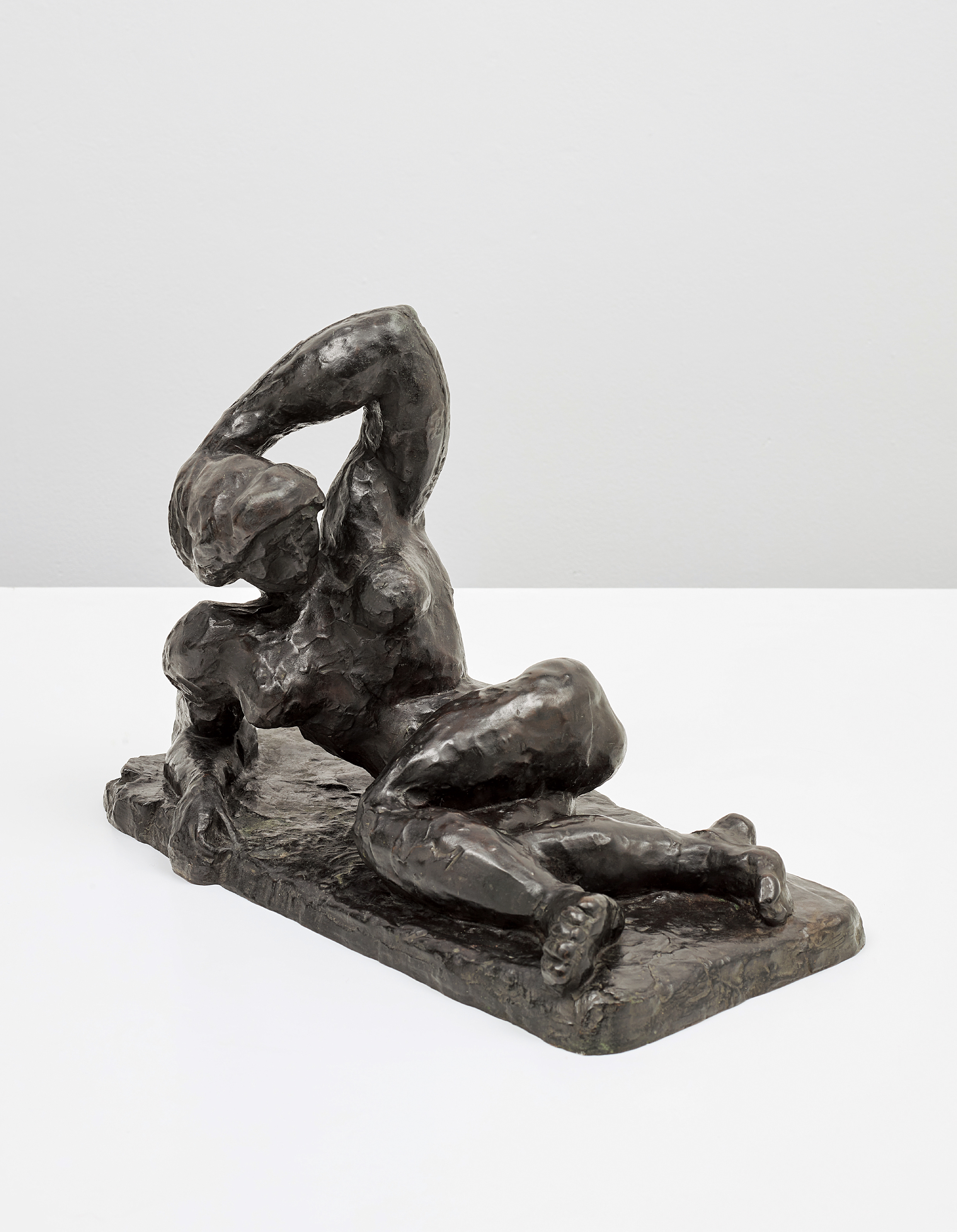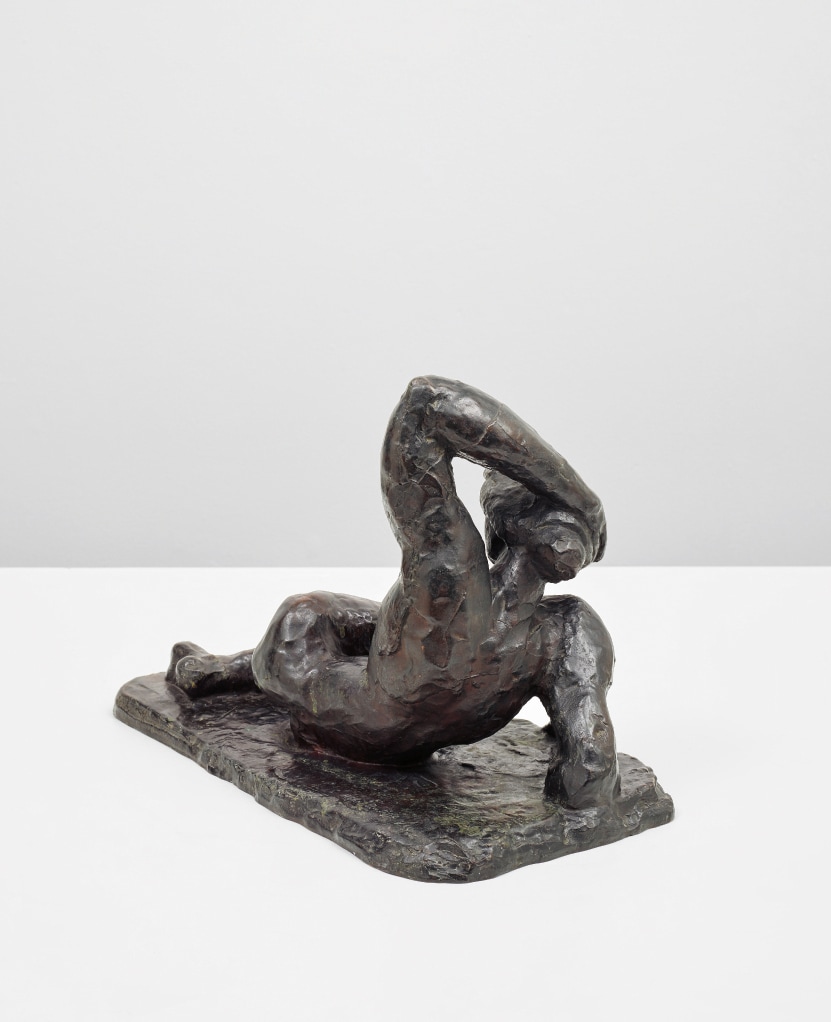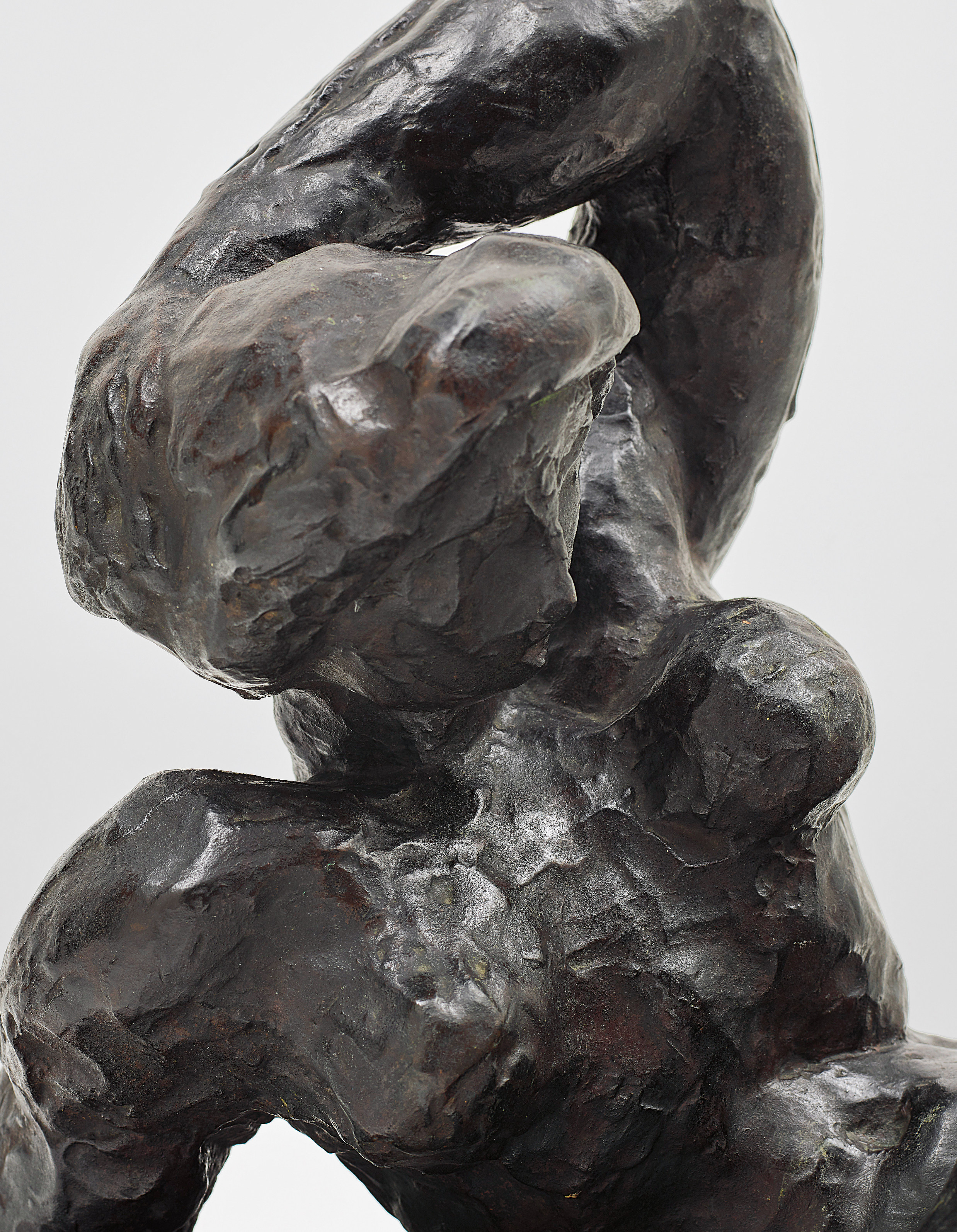





9
Henri Matisse
Nu allongé I (Aurore)
Phillips wishes to thank:
Les Archives Matisse and Mrs Wanda de Guébriant for their expertise
Mrs Elizabeth Royer for her extensive research on the provenance of this work
Dr Charles Stuckey for his contribution to the catalogue entry
Full-Cataloguing
Cast circa 1908
In the collection of the Musée National d'Art Moderne, Centre Georges-Pompidou, Paris
Number 2:
Cast circa 1908
Private Collection
Number 3:
The present work
Number 4:
Cast circa 1912
In the collection of the Albright–Knox Art Gallery, Room of Contemporary Art Fund, Buffalo
Number 5:
Cast circa 1912
Christie’s, New York, 9 November 1999, lot 504
Number 6:
Cast circa 1930
In the collection of the Baltimore Museum of Art, Maryland
Number 7:
Cast circa 1930
In the collection of the Musée d'Art Moderne de la Ville de Paris, Paris
Number 8:
Cast circa 1930
Phillips, New York, 7 May 2001, lot 17
Number 9:
Cast circa 1948
Private Collection
Number 10:
Cast circa 1951
Christie’s, New York, 19 November 1986, lot 26
In the collection of the Nasher Sculpture Center, Texas
Number 0:
Cast 1951
In the Artist’s family collection
Nu allongé I, finished in 1907, and first cast in bronze shortly afterwards, was singled out as 'one of Matisse's masterpieces' by perhaps the artist's best informed advocate, Alfred H. Barr, Jr., the founding director of the Museum of Modern Art, in his seminal, Matisse, His Art and his Public, 1951. As if to suggest that Nu allongé I is the quintessential Matisse sculpture, it was selected for the dust jacket of The Sculpture of Henri Matisse, the classic account by Albert E. Elsen, published in 1972. Posed with her muscular limbs twisting across her torso gymnastically to find equilibrium like a three‐dimensional seesaw, balanced from every point of view, Matisse's Nu allongé I introduces one of the hallmark motifs that Matisse returned to throughout his career.
Many of his most ambitious pre‐World‐War‐I figure paintings feature variations on this same sinuous pose, several of these displayed prominently on the left side of his intensely self‐revealing Red Studio, 1911 (MoMA). Such iconic Matisse works as The Pink Nude (Baltimore Museum of Art), 1935; his great charcoal drawings of 1938; and even his 1952 paper cut‐out Blue Nudes are all reprises of the pose first perfected in Nu allongé I. Engaged by the sculpture's complexity, Pablo Picasso immediately began to develop his own versions of this abstract pose and continued to do so throughout his own long career. Hardly less modern with the passage of time, Nu allongé I takes pride of place among the paradigms of 20th‐century style celebrated in the art about art mural proposed by Roy Lichtenstein in 1997 for the Bellagio Hotel.
The fundamentally traditional pose of a luxuriating female nude goddess from the Golden Age, alluding to famous images of Ariadne and Venus in Greco‐Roman sculpture and Renaissance paintings, appeared obsessively in Matisse's most ambitious exhibition works from 1905 with Luxe, Calme et Volupté. In the spring of that same year, the celebrated Auguste Rodin (to whom Matisse once showed his drawings for critique) presented his Ariane at the Salon des Beaux‐Arts, an armless reclining nude posed as she pivots her weight on her hip just like Matisse's Nu allongé I would do. And at the Salon d'automne of 1905 Renoir exhibited one of the monumental horizontal format paintings of a reclining female nude that preoccupied him now that bad arthritis prevented him from lifting his arm. It was at this same exhibition that Aristide Maillol won lavish praise for a sculpture eventually entitled La Mediterranée, a perfectly proportioned female nude, posed seated with her arms and legs in interlocking silhouettes.
The figure of a nude reclining on the ground was again at the epicenter of Matisse's monumental painting, Le Bonheur de vivre, presented in 1906 at the Salon des Indépendants and acquired by the expatriate American writers, Gertrude and Leo Stein. These increasingly avid collectors famously patronised Picasso no less than Matisse, befriending them both and nurturing an essential dialogue between the two emerging leaders of modern art. Their brother Michael Stein and his wife Sarah acquired one of the three earliest bronze casts of Nu allongé I as part of the display of Matisse works in their Paris apartment. The present lot is likewise one of these rare early casts by Bingen et Costenoble, the foundry used by Maillol. Meanwhile Leo Stein acquired Matisse's nearly life‐sized Blue Nude (Baltimore Museum of Art), which was created in response to this same tabletop sculpture.
By 1900 Matisse was seriously interested in making sculptures, but his output was sporadic throughout his long career. He first exhibited a few of them in early 1906, including a statuette of a standing female nude posed with her knee bent and her elbows raised to her head. Figures with raised elbows appear frequently in works by two of Matisse's favorite masters, Rodin and Paul Cézanne, largely predicated on Michelangelo's Dying Slave in the Louvre, and the reclining figure of Dawn from his Medici tomb complex in Florence. (Indeed, given the obvious similarities, Nu allongé I has sometimes been called Aurore.) Michelangelo's works were widely reproduced around 1875 to commemorate the four hundredth anniversary of his birth. Matisse's interest in the raised elbow pose is first evident in 1903 when Matisse made a roughly modeled replica of a work then attributed to Michelangelo, a seated male nude with his left elbow dramatically elevated. Oddly, this raised elbow is missing from Matisse's fragmentary replica, as if it had broken off accidentally, but Matisse nevertheless wanted to preserve the visual impact of his work in its incomplete or damaged state. Nu allongé I was the last of four statuettes that preoccupied Matisse in 1906, one of three to feature raised elbows. Thirty‐five years after the fact Matisse still vividly recalled how Nu allongé I also suffered accidental damage.
When asked about his work as a sculptor by writer and critic Pierre Courthion in 1941, (pp. 85‐86), Matisse explained that after he arrived for a long stay in Collioure in November of 1906, he often took the train to visit Maillol, in nearby Banyuls. Starting out as a painter, Maillol had only turned to sculpture in his mid‐thirties, but by 1906 he was acclaimed by Rodin as the finest sculptor of his generation. As he modeled Nu allongé I in clay, Matisse surely was mindful of Maillol's demanding criteria for modern figure sculpture in the round. That notwithstanding, Matisse was so absorbed in refining this time‐consuming work that one day he missed his train to Banyuls, and his sculpture in progress was damaged when it accidentally slid to the floor. The extended elbow would be especially vulnerable. Rather than continue, Matisse put Nu allongé I aside and painted his monumental Blue Nude (Baltimore Museum of Art), seemingly in response to Renoir's horizontal nudes with bodies that fill nearly the entirety of the canvas. Observed from above, the figure in Blue Nude is posed like Nu allongé I, but it seems restricted when compared with the sculpture that he had considered from every possible angle as if its different silhouettes were facets of a prism. 'The bronze is less imposing in size than The Blue Nude yet, in a sense, the big painting served as a study for the sculpture,' according to Barr. 'The sculpture is more powerfully composed, the distortions bolder, particularly in the bent but towering left arm. No sculpture by Matisse is more admirably designed to interest the eye and satisfy the sense of rhythmic contrapposto when seen from different points of view.' (p. 100). Nevertheless, the painting amounts to a full‐scale version of the tabletop bronze, as if Matisse was curious to see the impact of a monumental version of his sculpture. In his painting, Music Lesson (Barnes), 1916, Matisse indeed imagines a large version of Nu allongé I, as his garden sculpture.
There are telling similarities and differences between Nu allongé I and Maillol's sculptures. Counterbalancing their models' bent and extended arms and legs in rhythmic harmonies, both artists treated the poses as abstract structural compositions rather than as familiar actions. But whereas Maillol sought perfection overall, in the proportions of his figures and the refinement of every detail from the navel to the toes, Matisse preferred to emphasize his own evident struggles as an artist in the process of obtaining perfect compositional harmony. Matisse ignored inessential anatomical details like fingers and in the spirit of Rodin he emphasised traces of his own finger marks as they added or removed clay from body shapes to get the right mass or silhouette. Concerned no less with his final form than with the process of its making, in his bronzes Matisse not only preserved traces of his fingers and scalpel or spatula in roughly handled textures, but he also preserved the seams of the moulds used in casting, as Rodin often did. Observed close up, the back of the Nu allongé I's left shoulder is full of imperfections that appealed to the artist, who was determined for his work to stand apart from tasteful figure sculptures. Starting around now for the remainder of his long career, no matter what medium he used, Matisse found ways to express the intimate theme of his own artistic process, a theme hardly less paramount for Picasso. A double image of awareness and self‐ awareness, Nu allongé I is as much, if not more, the image of the making of the sculpture as it is the image of a nude woman. For art historian Jack Flam Nu allongé I is 'one of Matisse's most dissonant works, characterized by extreme anatomical distortions and abrupt turnings of form in space.' Indeed, for Flam the exaggerated size of some body parts, like the left arm, and their lack of proportion to each other may be an indication of Matisse's enthusiasm for African figure sculptures with articulated limbs. Whatever the case may be, the upper torso of Nu allongé I, with its too widely spaced breasts, appears too large in relationship to the figure's waist, and from some angles the raised left elbow appears strangely as large as the hip and thigh. It is the perfectly integrated composite of separate, imperfectly matched, parts into a final abstract whole of stunning harmony that makes Nu allongé I so masterful.
Matisse's personal satisfaction with Nu allongé I is evident from how during the next ten years he included the (now lost) plaster cast of his sculpture into a series of remarkable still‐life paintings and domestic scenes, as if his sculpture should be understood as a special touchstone, a miniature three‐dimensional muse at ease presiding in his abstract depictions of two‐dimensional pictorial spaces. With these still‐lifes Matisse paid ongoing hommage to Édouard Vuillard who included a plaster of Maillol's statuette Leda alongside cut flowers and other domestic items in several still‐lifes from the early 1900s.
As for Picasso, his immediate response to Nu allongé I has often been noted in the series of abstract nudes with raised elbows and twisted poses that he made in 1907, culminating in his historic Les Demoiselles d'Avignon. But it is not until 1998 that critic Yve‐Alain Bois first analysed Picasso's second, seemingly delayed reaction to Matisse's sculpture around 1930. He pointed out how Matisse's sculptures returned to Picasso's attention thanks to a special feature in a 1928 issue of the lavish art periodical Cahiers d'art, illustrating sculptures made by modern painters and shortly afterwards in the summer of 1930 by an exhibition of Matisse's sculptures at the Galerie Pierre. Picasso immediately embarked on a group of profoundly abstract figurative sculptures at his new Boisgeloup studio, including a reclining nude with her elbow raised, consisting of interlocking body parts disproportionate to one another, many out of place with reference to the rules of anatomy with respect to one another. These sculptures led directly in 1932 to a series of paintings of Picasso's young mistress Marie‐Thérèse Walter in poses similar to those used by Matisse.
By the most fortunate coincidence this sale also includes Picasso's masterpiece, La Dormeuse, (see lot no. 10) a monumental horizontal format image made on March 13, 1932, that represents the young woman asleep, the outlines of her body captured in arcing lines for the arms and buttocks, with stylized signs for her breasts and vulva, her anatomy distorted to display every side of her nudity at once. Traces of slightly all but erased lines show where Picasso first thought to position the breasts more prominently. More important these erasures seemingly document the artist's need to revise his portrayal of her as her body turned and twisted while she slept, her face at first turned up, and subsequently turned down to rest against her arms. Sharing Matisse's profound interest in representing the creative process itself, with traces of the needed corrections, Picasso in La Dormeuse seems once again to respond to Matisse's great Nu allongé I. Indeed for the remainder of their careers both artists felt compelled to make figures that twist to reveal themselves in every way at once. Matisse most explicitly revisited his Nu allongé I, not to mention Picasso's versions of similar poses, with Pink Nude, 1935, documenting the stages of its evolution in a series of twenty‐two photographs, the reclining nude’s arms and legs twisting now one way, now another. No wonder that when Matisse visited Antibes in April 1948 to see recent works by Picasso in the Palais Grimaldi, he was especially intrigued with a horizontal work on plywood representing a reclining nude with her elbow raised over her head.
Henri Matisse
French | B. 1869 D. 1954The leading figure of the Fauvist movement at the turn of the 20th century, Henri Matisse is widely regarded as the giant of modern art alongside friend and rival Pablo Picasso. Working as a painter, draughtsman, printmaker and sculptor for over five decades, he radically challenged traditional conventions in art by experimenting with vivid colors, flat shapes and distilled line. Rather than modeling or shading to lend volume to his pictures, the French artist employed contrasting areas of unmodulated color. Heavily influenced by the art and visual culture of non-Western cultures, his subjects ranged from nudes, dancers, odalisques, still lifes and interior scenes and later evolved into the graphic semi-abstractions of his cut-outs of his late career.